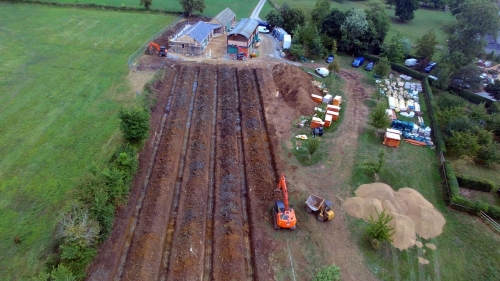How do I calculate the amount of space I need for a Ground Source Heat Pump?
In order to properly calculate the size of a ground collector array for a ground source heat pump, we need to work out a few things. Firstly, how much heat do we need to put into the building to keep it at a comfortable temperature? In the UK we have a wide variety of building types, sizes, and build quality so the amount of heat required to keep the building warm also varies.
A four-bedroom semi-detached house built in the late 2000s will need much less heat than a four-bedroom period cottage of the same size with single glazing and poor insulation. So we use our previous experience with different building types to establish an estimated Watts per m2 of building surface area across all stories.
For example, the well-insulated 2000s four-bed house may have a heat loss figure of 40 W/m2 whilst our leaky cottage could be as high as 90 W/m2. Assuming both houses have the same floor area of 250m2, our new house needs a 10kW heat pump whilst our period cottage needs over 22kW.
Once we have established how much heat is needed for your building, we know how much energy we need to extract from the ground to supply the ground source heat pump. This dictates the size of the horizontal ground source heat pump collector array. A well-installed ground source heat pump can extract about three-quarters of the energy required from the ground, so considering our period cottage, we need a ground array big enough to extract 16.5kW sustainably.
How does Isoenergy calculate the space needed for ground arrays?
Isoenergy uses a linear horizontal trench system for the majority of our ground arrays. This allows us to extract roughly 15W per meter of pipe in the ground so we need a sizable 1,100 meters of collector pipe for our period cottage.
We lay our collector pipe in linear trenches 1m wide, running the pipe down one side of the trench, looping at the bottom, and back up the other side. So, we need a total of 550m of trench for our period cottage. The smallest loop of pipe we normally use will be 200m, so we are going to need six loops of 200m each (rounding up) in trenches 100m long.
The final calculation is the gap between the trenches. This needs to be a minimum of about four meters between trenches and each trench is one meter wide means we need a total width of 30m by just over 100m to install a suitable horizontal array for our period cottage.
Granted, this is a complex calculation but we can aggregate it down to some basics for you. You will need space at least 100m long to fit in a horizontal collector array, and we need approximately 12m2 per m2 of your floor area for a very leaky house. This will give you a maximum area required for the vast majority of buildings in the UK. Of course, there are exceptions to this rule of thumb.
If there is insufficient space for a horizontal collector array, there are still other options available. If there is running water on your land, we can extract heat from that with EnergyBlade river heat exchangers. If there is a body of standing water like a lake, we can use lake loops. If all else fails, we can install a vertical ground array using boreholes to drill down, requiring a much smaller surface area.
Isoenergy can help you assess if you have the required space as part of our free consultation service. Using Google maps and some details about the building to be heated, we can quickly assess viability for a horizontal collector array and advise on other options if required. You can contact us today on 01293 821 345 where one of our consultant engineers will be able to help.







